Opinion & Analysis
Behind the numbers: A road map for an 18 handicap to get down to a 9
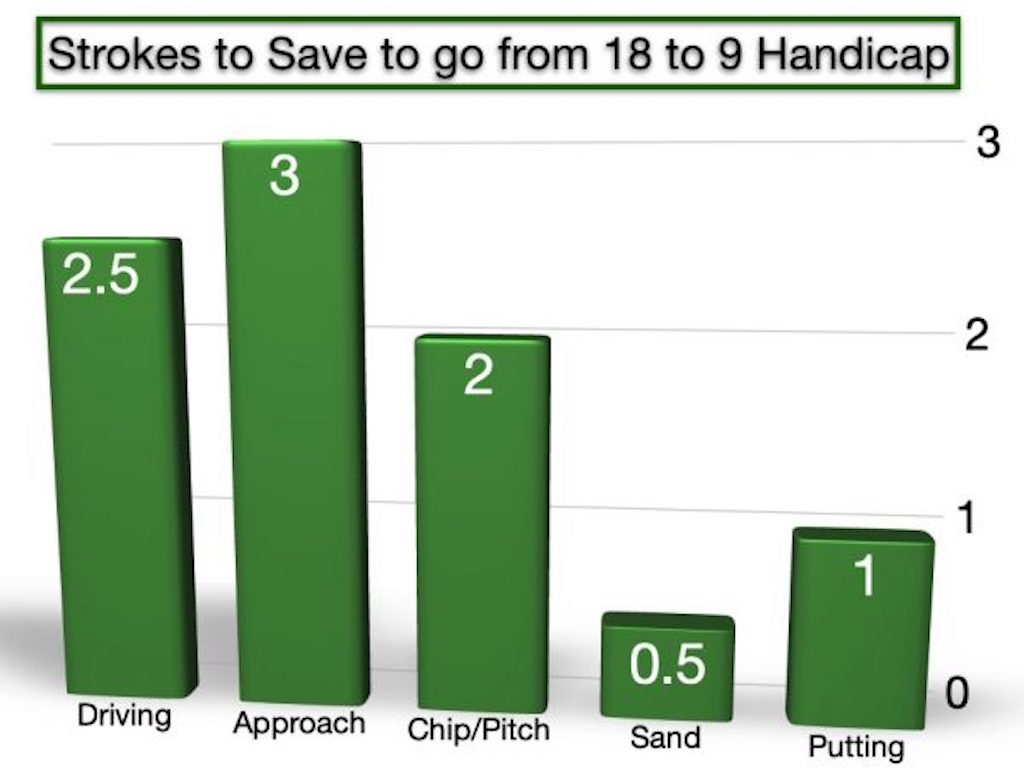
I wrote an article four years ago for GolfWRX called “The statistical differences between a scratch golfer and a PGA Tour player.” This article became one of the most-viewed features for the site, totaling over 420,000 views to date. I recently consulted with Ben Alberstadt, GolfWRX’s Editor-in-Chief, about pulling together some numbers for handicap levels to which more of us can relate.
You might ask: How do I know the differences between these handicap levels? Well, it is my full-time job to know about the numbers behind the game of golf—at all levels. I have been a student of the game from a statistical standpoint for 30-plus years. I created the strokes gained analysis website, ShotByShot.com, used by thousands of amateur golfers to improve by isolating the strengths and weaknesses of their games. Additionally, I work with PGA Tour players to extract clear answers from the Tour’s overwhelming 650-plus ShotLink stats.
I’ve learned that there is no such thing as an “average” game, no matter the handicap level. We’re all snowflakes and find our own unique way to shoot our number. With that said, ShotByShot.com’s 384,000-plus round database enables us to create a composite of the average golfer at each level. One of the beauties is that our data is robust and smooth across all five major facets so that any golfer’s strengths and weaknesses—and we all have them—stand out clearly by comparison.
The Data We Used
- 18 Handicap: I averaged the 3,551 rounds in our database that match the 18 Differential from Slope Adjusted Course Rating. In other words, the Best eight of 20 rounds when Mr. 18 actually played to an 18 handicap.
- 9 Handicap: Similarly, his Best eight out of 20 using the 5,000 applicable rounds in our database.
As you might guess, the difference between these two in scores is nine strokes. So, if your snowflake matches or is close to Mr. 18’s, simply drop the shots below by facet and voila you are there.
The chart below shows the distribution of the strokes by facet that Mr. 18 needs to save to join Mr. 9.
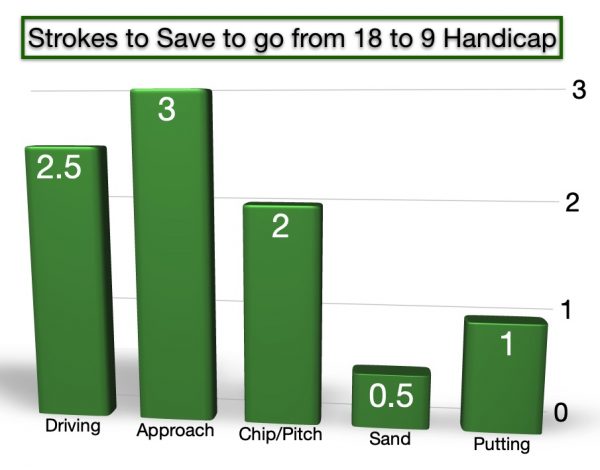
Driving
Skill in this critical facet of the game is measured by distance and accuracy. But let’s take distance out of the equation by assuming we’re all playing the correct tees for our games and focus on accuracy.
As the chart above indicates, we are looking for 2.5 strokes on, what for a typical golf course, is 14 driving holes. The chart below shows results in the average round for Mr. 18 and Mr. 9. Note that both make at least one Driving Error* per round. Weed out that error and you can be more than halfway home, especially if it is a Penalty Error** that tends to carry a cost of between 1.3 strokes (penalty with drop) and two-plus strokes (stroke and distance).
*No Shot Driving Errors = Balls hit out of play that cannot return to normal play with an advancement shot.
**Penalty Error = a. Stroke with drop, or b. Stroke and distance.
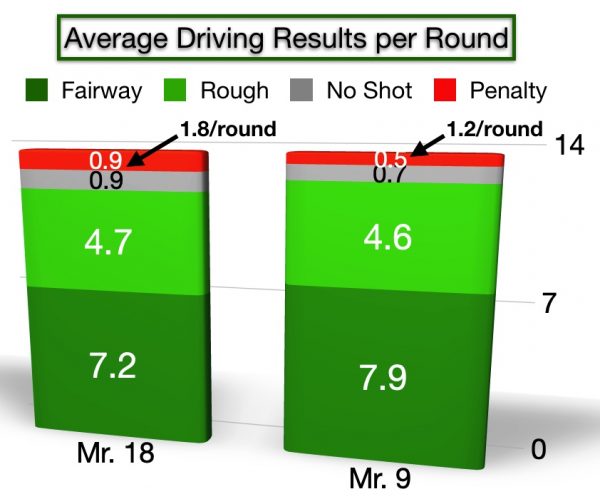
This may be easier said than done, but sometimes the fix is as simple as target and club selection from the tee. Sure, it works to aim away from trouble but try choosing a club that cannot reach the trouble. Most holes that feature trouble off the tee will also be stroke holes, even for Mr. 9. Avoid the error and take double-bogey out of play. This is also a valuable strategy for match play situations.
Next, strive to hit at least one more fairway. The approach accuracy charts below show how many more greens are hit from the fairway vs. rough.
Approach Shots
Here we need to save 3 strokes. This facet involves the greatest number of long game opportunities–on average 17.6 full swing attempts per round. These attempts are generally split 70 percent from the fairway and 30 percent from the rough. Let’s ignore the sand for now as it accounts for approximately only 1 shot every three-plus rounds. Except to say that when you find yourself in a fairway bunker, it is usually a mistake, so take your medicine, get back in play and avoid doubling the pain.
So where to save three strokes? Avoid penalties and that’s at least one stroke. Then hit three more greens in regulation and you’re there–Mr. 18 averages five GIRs vs. Mr. 9’s eight. The key is to improve accuracy.
I recommend working on the distance ranges circled in the charts below and devoting 70 percent of your work to fairway shots. From distances longer than the circled ranges, make smart choices, play within your capabilities and avoid errors and penalties. Easy?! At either handicap level, from long-range you’ll miss more greens than you hit. Knowing this, work toward “good misses” – the fat side of the green, short but in the fairway, etc. Finally, my data supports that hitting the green is far more important than worrying about “proximity to the hole”. But that’s another article.
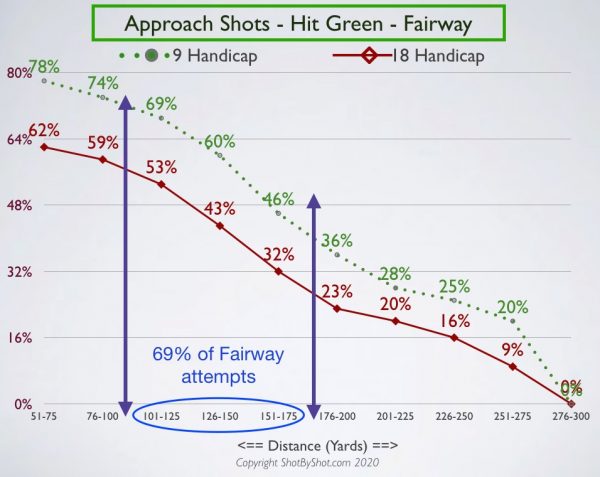
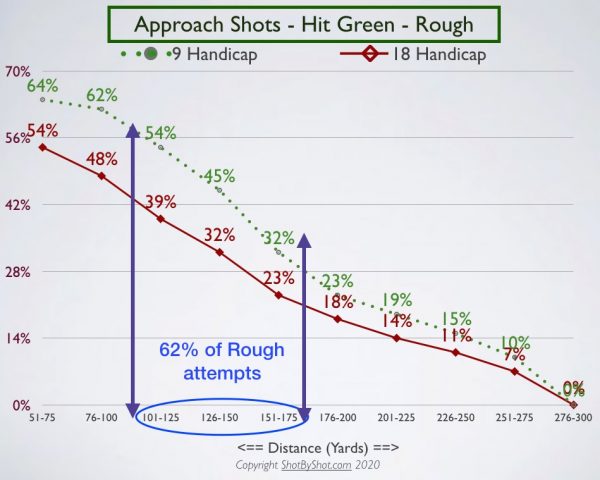
Chip/Pitch Shots (within 50 yards of the hole)
Here we are looking to save 2 strokes in a less frequently used part of the game–ten shots per round for Mr. 18 vs. eight shots for Mr. 9. Again, please start with avoiding Errors*. My pro and mentor spent hours on the short game with me. First, valuable technique instruction and then competitions @ $1.00 per shot—best lessons ever! His method was to break the shot opportunities into three categories, and this goes for the Sand game as well. Try it—it works.
- Green light: Good lie, no trouble–try to hole it
- Yellow light: Difficult but doable–play conservatively and try to be left with an uphill, makeable putt.
- Red light: Very difficult with looming downside–just get the ball on the green and avoid the error.
Next, practice the type of shots that you face the most and especially those that tend to give you problems. Bottom line, hit more shots closer to the hole and avoid costly errors. While this sounds like annoyingly obvious advice, maybe it will help to consider that Mr. 18 saves 20 percent of these opportunities vs. 32 percent for Mr. 9.
*Short Game Errors: The shot misses the green AND requires 4 or more strokes to hole out.
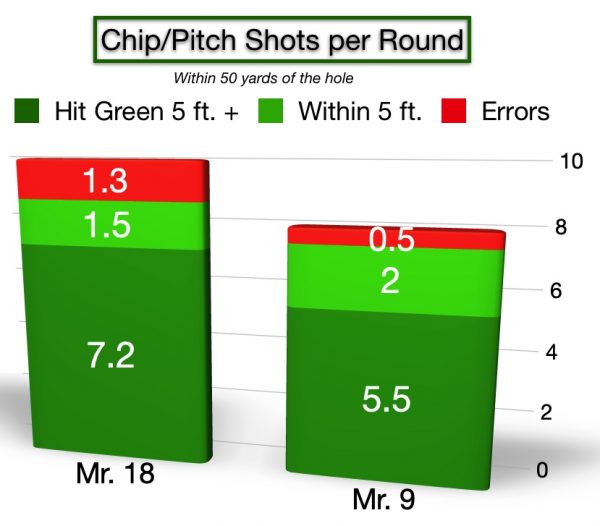
Sand Shots (within 50 yards of the hole)
Here we are looking to save half a shot in a very small part of the game—just 2 and 1.6 shots per round respectively for Mr. 18 and Mr. 9. I view this an underrated skill that definitely produces more errors per attempt than any other part of the game. When I was learning the game, I was afraid of the gaping bunkers that surrounded and protected ALL of our 18 greens. It wasn’t until I worked hard to gain real confidence from the sand that the greens seemed larger and easier to hit. Again, avoid errors and you’ll solve this portion of the puzzle. Mr. 18 saves 12 percent of his sand opportunities (with 28 percent errors) vs. 21 percent saves for Mr. 9 (15 percent errors).
*Short Game Errors: The shot misses the green AND requires 4 or more strokes to hole out.
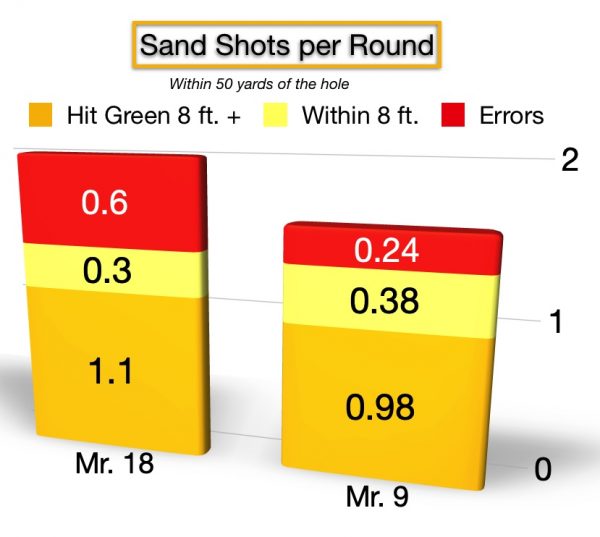
Putting
Putting is 40 percent of the game at all levels and we need to save 1 stroke. EASY, Mr. 18 simply needs to reduce his 3-putts from 2.5 per round to 1.5. Do this by working on distance control from 20 to 50 feet. Beyond 50 feet think of it as more of an easy chip shot with your putter. You’re doing well if you leave it within 10 percent of the original distance and below the hole. Finally, work on your short putts in the three-to-10-foot ranges. I recommend starting with three feet, then move to four to five feet. If you can get those ranges to Mr. 9’s one-putt numbers, you’re well on your way.
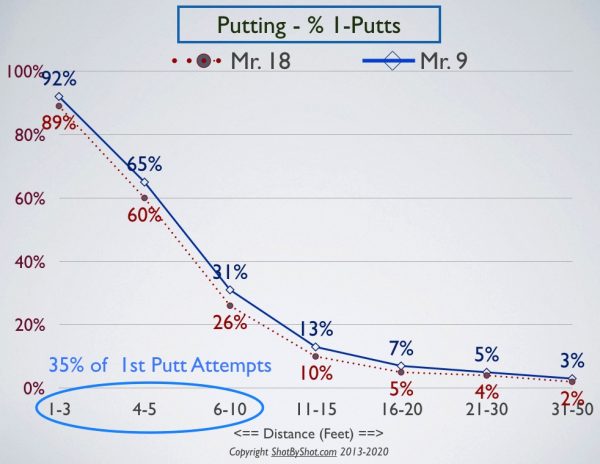
Conclusion
Bottom line, I have laid out where, on average, Mr. 18 needs to improve to make the leap to Mr. 9. If you made it this far, you may be saying, “Why all the focus on errors?” Simple! They are important! Most stat programs ignore them—the PGA Tour certainly does. My studies show that the relative frequency and severity of errors do more determine one’s scoring level than do all the good and average shots played.
Your game will no doubt have different areas of strength and weakness. The key is to accurately identify them so that you can address them appropriately. This article has hopefully given you some ideas about how to do that.
For a complete strokes gained analysis of your game, go to: www.ShotByShot.com
- LIKE443
- LEGIT48
- WOW14
- LOL8
- IDHT3
- FLOP2
- OB3
- SHANK11
19th Hole
Vincenzi’s 2024 Zurich Classic of New Orleans betting preview

The PGA TOUR heads to New Orleans to play the 2023 Zurich Classic of New Orleans. In a welcome change from the usual stroke play, the Zurich Classic is a team event. On Thursday and Saturday, the teams play best ball, and on Friday and Sunday the teams play alternate shot.
TPC Louisiana is a par 72 that measures 7,425 yards. The course features some short par 4s and plenty of water and bunkers, which makes for a lot of exciting risk/reward scenarios for competitors. Pete Dye designed the course in 2004 specifically for the Zurich Classic, although the event didn’t make its debut until 2007 because of Hurricane Katrina.
Coming off of the Masters and a signature event in consecutive weeks, the field this week is a step down, and understandably so. Many of the world’s top players will be using this time to rest after a busy stretch.
However, there are some interesting teams this season with some stars making surprise appearances in the team event. Some notable teams include Patrick Cantlay and Xander Schauffele, Rory McIlroy and Shane Lowry, Collin Morikawa and Kurt Kitayama, Will Zalatoris and Sahith Theegala as well as a few Canadian teams, Nick Taylor and Adam Hadwin and Taylor Pendrith and Corey Conners.
Past Winners at TPC Louisiana
- 2023: Riley/Hardy (-30)
- 2022: Cantlay/Schauffele (-29)
- 2021: Leishman/Smith (-20)
- 2019: Palmer/Rahm (-26)
- 2018: Horschel/Piercy (-22)
- 2017: Blixt/Smith (-27)
2024 Zurich Classic of New Orleans Picks
Tom Hoge/Maverick McNealy +2500 (DraftKings)
Tom Hoge is coming off of a solid T18 finish at the RBC Heritage and finished T13 at last year’s Zurich Classic alongside Harris English.
This season, Hoge is having one of his best years on Tour in terms of Strokes Gained: Approach. In his last 24 rounds, the only player to top him on the category is Scottie Scheffler. Hoge has been solid on Pete Dye designs, ranking 28th in the field over his past 36 rounds.
McNealy is also having a solid season. He’s finished T6 at the Waste Management Phoenix Open and T9 at the PLAYERS Championship. He recently started working with world renowned swing coach, Butch Harmon, and its seemingly paid dividends in 2024.
Keith Mitchell/Joel Dahmen +4000 (DraftKings)
Keith Mitchell is having a fantastic season, finishing in the top-20 of five of his past seven starts on Tour. Most recently, Mitchell finished T14 at the Valero Texas Open and gained a whopping 6.0 strokes off the tee. He finished 6th at last year’s Zurich Classic.
Joel Dahmen is having a resurgent year and has been dialed in with his irons. He also has a T11 finish at the PLAYERS Championship at TPC Sawgrass which is another Pete Dye track. With Mitchell’s length and Dahmen’s ability to put it close with his short irons, the Mitchell/Dahmen combination will be dangerous this week.
Taylor Moore/Matt NeSmith +6500 (DraftKings)
Taylor Moore has quickly developed into one of the more consistent players on Tour. He’s finished in the top-20 in three of his past four starts, including a very impressive showing at The Masters, finishing T20. He’s also finished T4 at this event in consecutive seasons alongside Matt NeSmith.
NeSmith isn’t having a great 2024, but has seemed to elevate his game in this format. He finished T26 at Pete Dye’s TPC Sawgrass, which gives the 30-year-old something to build off of. NeSmith is also a great putter on Bermudagrass, which could help elevate Moore’s ball striking prowess.
- LIKE8
- LEGIT3
- WOW1
- LOL1
- IDHT0
- FLOP3
- OB1
- SHANK1
19th Hole
Vincenzi’s 2024 LIV Adelaide betting preview: Cam Smith ready for big week down under

After having four of the top twelve players on the leaderboard at The Masters, LIV Golf is set for their fifth event of the season: LIV Adelaide.
For both LIV fans and golf fans in Australia, LIV Adelaide is one of the most anticipated events of the year. With 35,000 people expected to attend each day of the tournament, the Grange Golf Club will be crawling with fans who are passionate about the sport of golf. The 12th hole, better known as “the watering hole”, is sure to have the rowdiest of the fans cheering after a long day of drinking some Leishman Lager.
The Grange Golf Club is a par-72 that measures 6,946 yards. The course features minimal resistance, as golfers went extremely low last season. In 2023, Talor Gooch shot consecutive rounds of 62 on Thursday and Friday, giving himself a gigantic cushion heading into championship Sunday. Things got tight for a while, but in the end, the Oklahoma State product was able to hold off The Crushers’ Anirban Lahiri for a three-shot victory.
The Four Aces won the team competition with the Range Goats finishing second.
*All Images Courtesy of LIV Golf*
Past Winners at LIV Adelaide
- 2023: Talor Gooch (-19)
Stat Leaders Through LIV Miami
Green in Regulation
- Richard Bland
- Jon Rahm
- Paul Casey
Fairways Hit
- Abraham Ancer
- Graeme McDowell
- Henrik Stenson
Driving Distance
- Bryson DeChambeau
- Joaquin Niemann
- Dean Burmester
Putting
- Cameron Smith
- Louis Oosthuizen
- Matt Jones
2024 LIV Adelaide Picks
Cameron Smith +1400 (DraftKings)
When I pulled up the odds for LIV Adelaide, I was more than a little surprised to see multiple golfers listed ahead of Cameron Smith on the betting board. A few starts ago, Cam finished runner-up at LIV Hong Kong, which is a golf course that absolutely suits his eye. Augusta National in another course that Smith could roll out of bed and finish in the top-ten at, and he did so two weeks ago at The Masters, finishing T6.
At Augusta, he gained strokes on the field on approach, off the tee (slightly), and of course, around the green and putting. Smith able to get in the mix at a major championship despite coming into the week feeling under the weather tells me that his game is once again rounding into form.
The Grange Golf Club is another course that undoubtedly suits the Australian. Smith is obviously incredibly comfortable playing in front of the Aussie faithful and has won three Australian PGA Championship’s. The course is very short and will allow Smith to play conservative off the tee, mitigating his most glaring weakness. With birdies available all over the golf course, there’s a chance the event turns into a putting contest, and there’s no one on the planet I’d rather have in one of those than Cam Smith.

Louis Oosthuizen +2200 (DraftKings)
Louis Oosthuizen has simply been one of the best players on LIV in the 2024 seas0n. The South African has finished in the top-10 on the LIV leaderboard in three of his five starts, with his best coming in Jeddah, where he finished T2. Perhaps more impressively, Oosthuizen finished T7 at LIV Miami, which took place at Doral’s “Blue Monster”, an absolutely massive golf course. Given that Louis is on the shorter side in terms of distance off the tee, his ability to play well in Miami shows how dialed he is with the irons this season.
In addition to the LIV finishes, Oosthuizen won back-to-back starts on the DP World Tour in December at the Alfred Dunhill Championship and the Mauritus Open. He also finished runner-up at the end of February in the International Series Oman. The 41-year-old has been one of the most consistent performers of 2024, regardless of tour.
For the season, Louis ranks 4th on LIV in birdies made, T9 in fairways hit and first in putting. He ranks 32nd in driving distance, but that won’t be an issue at this short course. Last season, he finished T11 at the event, but was in decent position going into the final round but fell back after shooting 70 while the rest of the field went low. This season, Oosthuizen comes into the event in peak form, and the course should be a perfect fit for his smooth swing and hot putter this week.

- LIKE12
- LEGIT3
- WOW1
- LOL1
- IDHT0
- FLOP1
- OB1
- SHANK1
Opinion & Analysis
The Wedge Guy: What really makes a wedge work? Part 1

Of all the clubs in our bags, wedges are almost always the simplest in construction and, therefore, the easiest to analyze what might make one work differently from another if you know what to look for.
Wedges are a lot less mysterious than drivers, of course, as the major brands are working with a lot of “pixie dust” inside these modern marvels. That’s carrying over more to irons now, with so many new models featuring internal multi-material technologies, and almost all of them having a “badge” or insert in the back to allow more complex graphics while hiding the actual distribution of mass.
But when it comes to wedges, most on the market today are still single pieces of molded steel, either cast or forged into that shape. So, if you look closely at where the mass is distributed, it’s pretty clear how that wedge is going to perform.
To start, because of their wider soles, the majority of the mass of almost any wedge is along the bottom third of the clubhead. So, the best wedge shots are always those hit between the 2nd and 5th grooves so that more mass is directly behind that impact. Elite tour professionals practice incessantly to learn to do that consistently, wearing out a spot about the size of a penny right there. If impact moves higher than that, the face is dramatically thinner, so smash factor is compromised significantly, which reduces the overall distance the ball will fly.
Every one of us, tour players included, knows that maddening shot that we feel a bit high on the face and it doesn’t go anywhere, it’s not your fault.
If your wedges show a wear pattern the size of a silver dollar, and centered above the 3rd or 4th groove, you are not getting anywhere near the same performance from shot to shot. Robot testing proves impact even two to three grooves higher in the face can cause distance loss of up to 35 to 55 feet with modern ‘tour design’ wedges.
In addition, as impact moves above the center of mass, the golf club principle of gear effect causes the ball to fly higher with less spin. Think of modern drivers for a minute. The “holy grail” of driving is high launch and low spin, and the driver engineers are pulling out all stops to get the mass as low in the clubhead as possible to optimize this combination.
Where is all the mass in your wedges? Low. So, disregarding the higher lofts, wedges “want” to launch the ball high with low spin – exactly the opposite of what good wedge play requires penetrating ball flight with high spin.
While almost all major brand wedges have begun putting a tiny bit more thickness in the top portion of the clubhead, conventional and modern ‘tour design’ wedges perform pretty much like they always have. Elite players learn to hit those crisp, spinny penetrating wedge shots by spending lots of practice time learning to consistently make contact low in the face.
So, what about grooves and face texture?
Grooves on any club can only do so much, and no one has any material advantage here. The USGA tightly defines what we manufacturers can do with grooves and face texture, and modern manufacturing techniques allow all of us to push those limits ever closer. And we all do. End of story.
Then there’s the topic of bounce and grinds, the most complex and confusing part of the wedge formula. Many top brands offer a complex array of sole configurations, all of them admittedly specialized to a particular kind of lie or turf conditions, and/or a particular divot pattern.
But if you don’t play the same turf all the time, and make the same size divot on every swing, how would you ever figure this out?
The only way is to take any wedge you are considering and play it a few rounds, hitting all the shots you face and observing the results. There’s simply no other way.
So, hopefully this will inspire a lively conversation in our comments section, and I’ll chime in to answer any questions you might have.
And next week, I’ll dive into the rest of the wedge formula. Yes, shafts, grips and specifications are essential, too.
- LIKE32
- LEGIT7
- WOW1
- LOL1
- IDHT2
- FLOP3
- OB1
- SHANK3
-

 19th Hole2 weeks ago
19th Hole2 weeks agoDave Portnoy places monstrous outright bet for the 2024 Masters
-

 19th Hole3 days ago
19th Hole3 days agoJustin Thomas on the equipment choice of Scottie Scheffler that he thinks is ‘weird’
-

 19th Hole2 weeks ago
19th Hole2 weeks agoTiger Woods arrives at 2024 Masters equipped with a putter that may surprise you
-

 19th Hole3 days ago
19th Hole3 days ago‘Absolutely crazy’ – Major champ lays into Patrick Cantlay over his decision on final hole of RBC Heritage
-

 19th Hole3 weeks ago
19th Hole3 weeks agoReport: Tiger Woods has ‘eliminated sex’ in preparation for the 2024 Masters
-

 19th Hole1 week ago
19th Hole1 week agoTwo star names reportedly blanked Jon Rahm all week at the Masters
-

 19th Hole1 week ago
19th Hole1 week agoReport: LIV Golf identifies latest star name they hope to sign to breakaway tour
-

 19th Hole1 week ago
19th Hole1 week agoNeal Shipley presser ends in awkward fashion after reporter claims Tiger handed him note on 8th fairway





















Jnak97
Apr 14, 2020 at 3:29 pm
I second the idea of doing another follow up article. Though, since your last article shows Mr. Scratch as a 73ish scoring average, maybe we could compare the single digit to someone that is averaging 1 or 2 under par. So I guess a +1 or +2 handicap would make a more informative comparison. We already have the stats for a 9 and 0 handicap based on this article and your previous, but it would be nice to have a reference for how to break par!
John Stafford
Mar 30, 2020 at 8:53 pm
Great analysis. I’ve learned (as a 20 handicapper) that I don’t need to hit the ball any longer (or even that much straighter) to be a 10 handicapper. All I need to do is take my best 9 holes and do it for 15 holes. No penalties. Quit using driver and switch to 3 wood at first sign of trouble (most holes only give you 0.2 strokes or so advantage with driver, one penalty outweighs the entire round). No muffed irons, no muffed chips, don’t hit into sand traps except with long irons. Aim for 2 putts instead of the cup. Wedge forward 70 yards from trouble vs. a low probability 150+ yard shot. If only my body wasn’t breaking down as I’m getting so much smarter.
Peter Sanders
Apr 3, 2020 at 10:38 am
Well done John, you solved the puzzle on your own just as I did years ago.
Chris G.
Mar 29, 2020 at 1:45 am
Is it possible to get the statistics to go from Mr. 9 to Mr. Scratch?
pls don’t make me wait 4 yrs, I could be an 18 by then
Peter Sanders
Mar 29, 2020 at 11:16 am
Chris,
Certainly possible. I discussed with the Editor following up with 5 handicap to Scratch. IF, this article were well received.
At the risk of sounding self-serving… If you subscribe to ShotByShot.com, you can select the lower handicap “Target” and the system will guide you to where you want to go. I suggest starting with the 6-9 Target range. When you get there, 4-5 and on down to 0-2 and even lower.
Thanks for your question and please let me know how you do.
Chris G.
Mar 29, 2020 at 12:05 pm
Thank you for the response Peter.
when my expendable income returns, I will give it a shot
Peter Sanders
Mar 30, 2020 at 10:09 am
I understand! Let’s hope it is still golf season!
Peter Sanders
Mar 30, 2020 at 10:10 am
Chris,
Are you somewhere where you can play now?
Chris G.
Mar 30, 2020 at 12:45 pm
The short answer is no. There is a golf course 1 hour away from me that is open, but I am only driving to work and the store. I rode my bike to my local muni but they are closed for now.
Bob Jones
Mar 27, 2020 at 10:15 am
I did just this. I did it by learning how to hit the ball straight, getting VERY good at approach putting and chipping, and learning how to play the game. There were other things, too, like learning how to hit from uneven lies, fairway bunkers, rough, greenside bunkers, chipping from strange places around the green, so I was seldom at a loss for how to stay on offense from challenging spots, but it was mainly those first three things.
Peter Sanders
Mar 28, 2020 at 10:52 am
Thanks Bob! Sounds like you worked hard and figured it out on your own. Well done!
Peter Sanders
Mar 27, 2020 at 9:50 am
I’m with you 100% Jack! My long time friends and I, that used to relish the challenge from the back tees, now unabashedly pass them and walk proudly to the Sr./forward tees. The game is still as fun and competitive!
Jack Nash
Mar 27, 2020 at 9:27 am
Great article
I haven’t used this tech language per say but over the years I’ve managed to play smarter. Getting older, having injuries and losing distance has taught me to use the right club(more club) more often and miss it on the proper side. Oh, and playing it forward makes the game fun again. If it’s feeling like work, you’re on the wrong tee box.